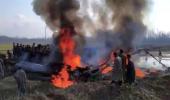In a war situation, the policy of 'what is not mine is enemy' tends to hold sway.
It is high time professional militaries took air defence seriously, notes Group Captain Murli Menon (retd).

Iran's admission that it had accidentally shot down an Ukranian passenger Boeing 737 plane Flight PS 752 in the fog of war over Tehran international airport, sad as it may be as an event, only shows the infallibility of the modern military - human interface combine.
A similar fiasco occurred in 1988 when an American warship shot down an Iranian passenger jet, killing 290 passengers.
In 2014, a Russian missile brought down a Malaysian civil airliner over Ukraine, killing 298 people.
It is unfortunate that the Indian Air Force recently joined this dubious bandwagon of wrongdoers by its 'blue on blue' downing of its MI-17 chopper over Srinagar during the aerial standoff with Pakistan in February 2019. This may not be the last such incident, unfortunately!
It is high time professional militaries took air defence seriously.
A weapon solution in air defence parlance is achieved through a combination of available defensive weapons over an intended target, such as shoulder fired and surface to air missiles, anti-aircraft guns and fighter interceptor aircraft.
These form an array of radar sensors, Identification Friend or Foe systems (normally integrated with the weapon platform) and even ground based Combat Air Patrol controllers which are then superimposed with some procedural methods such as Gun Fire Areas (where friendly aircraft are banned from flying, for security considerations).
In the Tehran instance, apparently the GFA would have been the Iranian Revolutionary Guard location in the vicinity of Khomeini airport, whose integral air defence weapons, possibly a short range SAM, were freed to engage any target deemed hostile.
There has to be a well trained air defence commander to orchestrate all these sensors and weapons and procedures to ensure that no friendly fire instance takes place.
This then is the weak link. As also evident in the IAF's Srinagar instance wherein the air defence Spyder missile controller was apparently blame worthy.
Iranian air defence commanders clearly lack in operational on the job experience given the American sanctions on their country and consequently paucity in training fighter flying and other sensor integration effort which translates to availability of abundant spares for the entire Iranian Air Force.
This was an accident waiting to happen.
In case of defensive organisations such as perhaps the Iranian Revolutionary Guard air defence network or the shooting down of the Malaysian plane over Ukraine in a war situation, the policy of 'what is not mine is enemy' also tends to hold sway.
Put a poorly trained air defence crew and a trigger happy air defence commander into the equation and you have the necessary heady mix for a miscalculated friendly fire incident.
Fog of war situations does lead to some friendly fire incidents all over the world.
But even in comparatively controlled situations the Peter Principle tends to operate (If something somewhere has to go wrong, it will!) and you have these kind of operational tragedies.
The Iranians's initial intransigence, blaming the incident on American adventurism, has already been proved wrong by the embarrassed admission by Iran's supreme leader Ayatollah Ali Khamenei, offering to bring the guilty to book.
The admission of culpability by Brigadier General Amir Ali Hajizadeh, the 's aerospace commander may serve to de-escalate the prevailing situation in the Middle East somewhat.
The expected inquiry into the 'accident', comprising Canadians, Americans and Ukranian agencies would only put a QED on the episode.
But who pray can bring back the innocent lives lost?!










